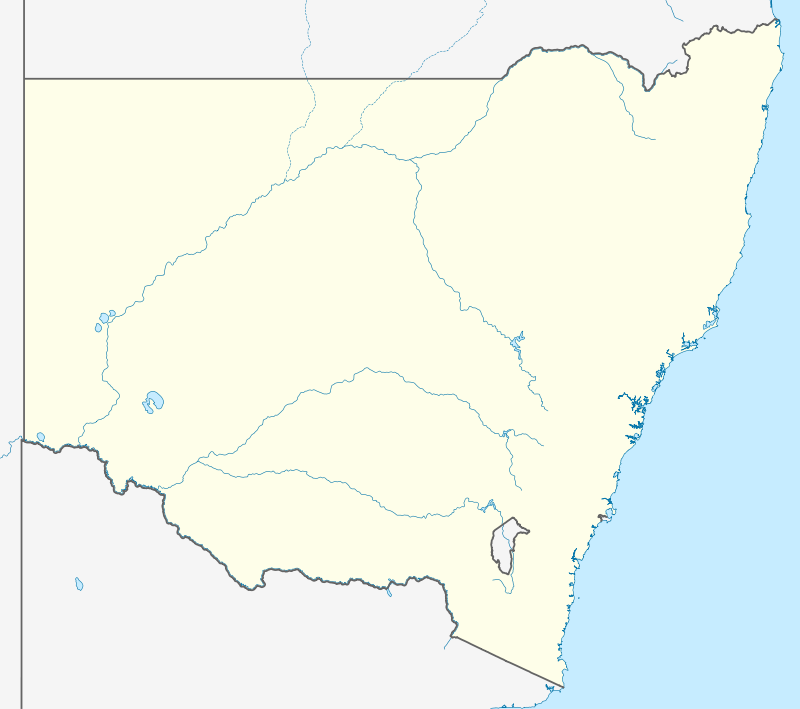Kureinji
The Kureinji, otherwise known as the Keramin, are an Aboriginal group whose traditional lands are located in the Northern Riverina of southwest New South Wales, Australia.
| Kureinji Traditional lands New South Wales | |
|---|---|
Murray River on Kureinji lands | |
 Kureinji Traditional lands | |
| Coordinates | 34°11′0″S 142°11′0″E |
Language
Kureinji was one of 35 languages spoken in this area of southwestern New South Wales, around and north of the border with Victoria.[1] Linguistically the tribe was part of the Lower Murray Areal group,[2] and with Yitayita and Tatitati forms a distinct subfamily.[3]
Country
According to Norman Tindale the Kureinji's traditional lands embraced some 1,700 square miles (4,400 km2) of territory, running in good part along the northern banks of the Murray River, ranging from the vicinity of Euston to Wentworth downstream.[4] Across the river from the Kureinji, Mildura, which is in Latjilatji tribal land, was first settled in 1847.
Kemendok National Park is part of their traditional land, and traces of their habitation remains in scar trees, fire hearths, flaked stone artefacts, burial sites and middens.[5]
History
Charles Sturt[6] passed through their country in 1830 but did not mention the Kureinji, Charles Lockhart in 1862 also appears to mention, without however actually specifying this tribe.[4] Many of the Kureinji today live in Mildura.
During colonial times, bodies were taken from five burial sites along the New South Wales side of the Murray River,[7] and are now part of the Murray Black Collection. Tribal groups have been seeking the repatriation of these bodies.[lower-alpha 1]
Alternative names
- Garnghes
- Grangema
- Jungeegatchere
- Kareingi
- Karin
- Kemendok
- Keramin
- Kerinma, Karinma, Karingma
- Kianigane
- Kinenekinene
- Orangema (misprint).
- Pintwa
Source: Tindale 1974
Notes
- "The Murray Black Collection was the largest collection of Indigenous Australian remains at the time of its donation, comprising approximately 800 individuals from the Maraura, Kureinji, Tati-tati, and Wati Wati peoples across five burial sites along the New South Wales side of the Murray River." (Prince 2015, pp. 11–13,11)
Citations
- von Zinnenburg Carroll 2014, pp. 85, 125.
- Dixon 2002, pp. xxxvi, 669.
- Hercus 1989, p. 56.
- Tindale 1974, p. 196.
- Statement 2014.
- Mildura history.
- Prince 2015, p. 11.
Sources
- Dixon, Robert M. W. (2002). Australian Languages: Their Nature and Development. Volume 1. Cambridge University Press. ISBN 978-0-521-47378-1.CS1 maint: ref=harv (link)
- Hercus, Luise (1989). "Three Linguistic Studies from Far South-Western NSW" (PDF). Aboriginal History. 13 (1): 45–62.CS1 maint: ref=harv (link)
- Prince, Jordi Rivera Rivera (2015). Can the Repatriation of the Murray Black Collection be Considered an Apology? Colonial Institutional Culpability in the Indigenous Australian Fight for Decolonization. In Situ. pp. 9–13. Archived from the original on 26 November 2016.CS1 maint: ref=harv (link)
- Statement of Management Intent Kemendok National (PDF). Office of Environment & Heritage, NSW. June 2014. pp. 1–6. ISBN 978-1-743-59685-2.
- Tindale, Norman Barnett (1974). "Kureinji (NSW)". Aboriginal Tribes of Australia: Their Terrain, Environmental Controls, Distribution, Limits, and Proper Names. Australian National University Press. ISBN 978-0-708-10741-6.CS1 maint: ref=harv (link)
- von Zinnenburg Carroll, Khadija (2014). Art in the Time of Colony: Empires and the Making of the Modern World, 1650–2000. Ashgate Publishing. ISBN 978-1-409-45596-7.CS1 maint: ref=harv (link)